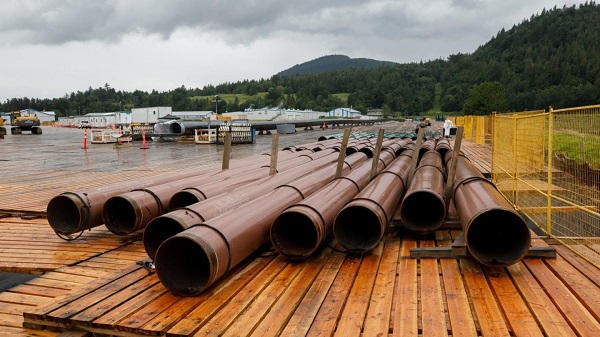Business
Canada’s risky and misguided bet on EV battery manufacturing

From the Macdonald Laurier Institute
By Tom McCaffrey and Denaige McDonnell for Inside Policy
By investing $52.5 billion in a handful of foreign-controlled companies, the government has failed to create a sustainable, long-term economic advantage. Instead of fostering innovation and building a robust, homegrown supply chain, Canada has committed itself to an outdated model of industrial policy that relies on foreign entities and low-value manufacturing jobs.
Two years ago, Canada’s minister of natural resources urged Canadians “to fully seize” the economic opportunity presented by the country’s abundant critical minerals.
“We must ensure that value is added to the entire supply chain, including exploration, extraction, intermediate processing, advanced manufacturing, and recycling,” Jonathan Wilkinson stated. “We must create the necessary conditions for Canadian companies to grow, scale-up, and expand globally in markets that depend on critical minerals.”
Two years later, the Canadian government has gone all-in with a $52.5 billion dollar bet on EV battery manufacturing in Ontario and Quebec. The decision goes against the recommendations of industry specialists and the government’s own departments responsible for strategic development who advised officials to go slow, steady, and think full supply chain development when targeting incentives.
Why didn’t the politicians listen?
Ottawa’s risky bet on EV battery manufacturing
By 2033, the Parliamentary Budget Officer (PBO) estimates three recent Canadian Government EV battery manufacturing subsidies will cost the country a total $37.7 billion dollars. The Northvolt, Volkswagen, Stellantis-LGES manufacturing facilities are estimated to take 15 years to pay back Canadian taxpayers.
The repayment estimate is 6 years longer than the government originally estimated because the PBO has now used the manufacturers’ production rate estimations, a more conservative number, than the originally used full production rates. In total, the national investment across the full value chain of EV battery manufacturing equates to $52.5 billion into just 13 companies.
The Canadian government is betting big on EVs, but not by investing in innovation, intellectual property, or Canadian technology. It is betting the farm on foreign entities delivering 8,500 manufacturing jobs. Capital investment for the purpose of growth in labour productivity isn’t a new strategy and it can be effective, but at $4 million per job the likelihood of return on investment is low.
Could the Bet Pay Off?
The global EV battery market is expected to surge over the next 10 years from US$132.6 billion in 2023 to US$508.8 by 2033. So far, growth has been slower than expected, and some major players, like Tesla, will be challenged to meet their sales volumes from last year according to analysts – but basing an opinion on a single year of car sales is not wise.
The truth is car manufacturing in Canada is important to our GDP ($14.6 billion) and to jobs (125,000). It is also true that Canada has lost 50 per cent of its market share in manufacturing of cars ($8 billion in 2000 to $4 billion in 2022), but it has maintained it market share in motor vehicle parts ($9 billion).
Canada appears to be betting that it can maintain it’s position in the car automotive industry rather than cementing its place in the battery metals and manufacturing value chain. But is this wager wise?
Sustainable policy development
Governments can encourage economic and industrial development in several ways. Policy-makers can set efficient regulations and approval mechanisms; create frameworks that build a bridge between government and the private sector; support the development of skilled labour and innovation ecosystems; enable direct collaboration and procurement mechanisms between industry, academia, innovation ecosystems, and government; and share a clear vision and pathway for industrial growth.
Governments can also use subsidies and tax credits to create market share, but there is growing concern that using these methods to create or protect markets will cause more harm than opportunity in developing countries. These kinds of investments risk triggering international protectionism and geopolitical trade-offs as nations turn inward rather than collaborating for development.
What’s needed is a sustainable policy approach – one that influences and benefits the largest subset of market outcomes, including start-up development, foreign direct investment, technology development, technology adoption, investment attraction, the creation of circular economy value chains, and more.
Ottawa’s misguided approach to economic investment
In the EV world, a fully integrated supply chain that includes mining, chemical processing, battery production, and recycling is critical. The battery value chain road map published by Innovation, Science and Economic Development (ISED) Canada, and the Canadian Critical Minerals Strategy published by Natural Resources Canada (NRC) both call for government to develop the full supply chain.
In 2021, a standing committee advised how best to develop the full supply chain. That same year Clean Energy Canada wrote a report on how Canada could build the domestic battery industry across the country, and in 2022 another full suite of associations including the Battery Metals Association, Energy Futures Lab, Transition Accelerator, and Accelerate ZEV developed a roadmap to develop Canada’s battery value chain.
The Canadian industrial policies being used to create the EV supply chain are a mix of production subsidies, investment tax credits, foregone corporate income tax revenue, construction capital expenses, and other monetary supports. Though large, the $52.5 billion investment ignores key aspects of the upstream supply chain (mining, refining, etc.) that would allow us to reap full value from EV battery production. Worse, it comes at a time when automakers are pulling back from EV investments due to lower than expected demands, making the investment increasingly risky given changing market conditions.
By flying in the face of the very industries it supports and specialists it employs, it raises the question: why is Canadian government failing to follow its own strategy? Why choose to support an undeveloped strategy that banks on foreign investment and manufacturing jobs when experts across Canada’s supply chain, and two government departments, had a fulsome and balanced approach to supply chain development? Why shun a balanced approach to government investment focused on building out the entire supply chain?
Where Canada continues to go astray
Canada’s investment strategies have long been plagued by short-term thinking, favouring politically motivated quick wins over sustainable, long-term value creation. The government’s $52.5 billion bet on EV battery manufacturing is a prime example—subsidizing foreign companies while neglecting the development of critical upstream supply chains and domestic innovation. This approach leaves Canada reliant on international markets for critical materials, with little to show in terms of intellectual property or R&D growth.
By ignoring expert advice and focusing on politically strategic regions, Canada misses opportunities to build fully integrated industries across the country, ultimately failing to support homegrown solutions that could foster long-term economic resilience. Instead, Canada continues to prioritize high-risk, low-return investments, with little consideration for the foundational elements needed for a competitive, innovative economy.
Research on industrial policy shows countries are better served when governments focus on delivering well-designed policies aimed at improving general business environments than attempting to artificially create new markets. This is why industrial policies went out of vogue more than two decades ago.
It raises the question – are there examples of successful government interventions that seeded new sectors?
How the Asia-Pacific region cornered the semiconductor market
In the 1980s both the South Korea and Taiwanese governments made strategic early investments in companies that were well positioned to accelerate growth of the semiconductor sector. Today, the Asia-Pacific region is dominating the global market share of what has become a US$620 billion industry. Both South Korea and Taiwan were investing in the semiconductor industry in the 1960s. From a policy perspective, the two countries took similar approaches and focused their state-directed capital allocations to companies like Samsung LG and the Taiwan Semiconductor Manufacturing Company (TSMC). Through strong government support, both countries created technology institutes, centres for research and development, infrastructure and tax incentives, tax holidays, and interest-free loans.
Those investments helped to seed highly successful sectors in each country. Both countries continue to invest tax dollars back into the sector to help maintain the competitive advantages they helped to foster. South Korea’s semiconductor industry received a $US19 billion show of support from its government earlier this year to create a comprehensive support program spanning financial, research and development, and infrastructure support. The investment is part of a decades long commitment to the semiconductor industry which now accounts for nearly 20 per cent of total exports and plays a leading role in the South Korean economy. In Taiwan, the semiconductor sector is a powerhouse that accounts for 15 per cent of the national GDP and ranks number one globally for wafer foundry and packaging and testing, and number two for integrated circuit (IC) design.
These successes were largely enabled by government-controlled economies and early, and ongoing support to industry. This support did not waiver for decades. It is unlikely that Canada will be able to maintain this level of stability and government focus.
Other factors like access to cheap labour, willingness to specialize, commitment to product quality, and streamlined manufacturing played an important role.
Policy Challenges: Economic and Political Complexities
The challenge of creating successful industrial policy is that it is complex, long-term, has uncertain benefits, and requires government departments to have deep industry expertise. Experts worry that the current federal government simply isn’t up to the task.
In 2023, more than 2,500 new industrial policies were introduced globally, and more than 70 per cent were subsidies, tariffs, or import/export restrictions. These policies create trade distortion more often than they lead to market creation. Trade distortion can unfairly tilt the playing field in favour of domestic industries, often at the expense of foreign competitors.
With Canada’s recent industrial policy on EV battery manufacturing, we are choosing to distort our own economy.
Industrial policies strain global trade and economic relations. Such policies can have wide-ranging effects on both the implementing country and the global economy. They also appear protectionist even to allied nations.
How can Canada get it right?
Many of Canada’s mature sectors have enjoyed government support or protection at some point in our nation’s history. Past Canadian governments have protected the industries of their time, be it agriculture, steel manufacturing, pulp and paper, aerospace, and even defence.
There are recent examples of small sums of government dollars creating big wins for Canada’s homegrown innovation and sustainability economy.
At the provincial level, one organization that stands out is Emissions Reduction Alberta (ERA), an arms-length provincial organization that has weather several changes in government in its 15 years. ERA uses Technology Innovation and Emissions Reduction dollars to invest in late-stage sustainable technology. To date, the organization has invested almost $1 billion dollars into 277 technologies at a ratio of 8 industry dollars to 1 ERA dollar.
Federally, Prairies Economic Development Canada (PrairiesCan) is an example of a highly innovative approach to economic development. It has invested millions of dollars in repayable interest-free loans and regional innovation ecosystem supports. Ecosystem supports include accelerators and incubators that have exponentially increased the success of start ups and mature firms alike.
PrairiesCan and ERA operate on annual budgets of $300 million and $50–200 million, respectively. These dollars employ various types of expertise and invest across large swaths of the mature and new economy. They look across hundreds of organizations, understand the regional context, varying business dynamics and make strategic investments.
If government persists in committing tax dollars to the growth of the economy, then it should draw inspiration from these kinds of organizations.
Do Governments Make Effective Market Makers?
Canadians are rightly skeptical about Ottawa’s $52.5 billion bet on EV battery manufacturing.
Ottawa is rolling the dice that it will make Canada a leader in battery supply chains. It’s one of the largest industrial policy bets we have seen in our lifetimes. However, industrial policy analysts are warning about the risk of misallocation of funds.
Expert critics say Canada’s economy is too reliant on government-driven innovation policies. These researchers believe that competition creates markets, and that the government should commit to focusing on reducing policy and regulatory barriers. Many still believe in the capitalist ethos – that fostering a cultural and economic environment that naturally supports risk-taking and competition is the best route to success. The same people would note that the natural process of business turnover is essential for innovation and growth.
Conclusion
Canada’s current strategy of picking winners through massive, targeted subsidies is not just risky – it’s short-sighted. By investing $52.5 billion in a handful of foreign-controlled companies, the government has failed to create a sustainable, long-term economic advantage. Instead of fostering innovation and building a robust, homegrown supply chain, Canada has committed itself to an outdated model of industrial policy that relies on foreign entities and low-value manufacturing jobs. This approach ignores the foundational elements that drive true competitiveness – innovation, R&D, and full value chain development.
What Canada needs is a fundamental shift in its investment strategy. Instead of betting the farm on politically motivated, high-risk subsidies, the government should focus on strengthening ecosystems that support innovation, entrepreneurship, and domestic industry. Investments should be directed at building a fully integrated supply chain that includes mining, refining, and manufacturing, while supporting Canadian companies that will keep intellectual property and jobs at home.
If Canada continues down the current path, it risks becoming a player in someone else’s game, perpetually reliant on foreign companies and global markets. The country should seize this moment to redefine its complete industrial strategy, making bold investments in innovation and infrastructure that can secure economic resilience for generations to come. Without this shift, Canada’s $52.5 billion bet may very well be remembered as one of the biggest missed opportunities in modern economic history.
Tom McCaffery, M.B.A., is the CEO and managing director of Two River Advisory and former executive director of policy and engagement for Emissions Reduction Alberta.
Denaige McDonnell, Ph.D., is an accomplished business management strategist and CEO of People Risk Management, specializing in organizational systems, culture, and psychological safety.
Business
UNDRIP now guides all B.C. laws. BC Courts set off an avalanche of investment risk

From Resource Works
Gitxaala has changed all the ground rules in British Columbia reshaping the risks around mills, mines and the North Coast transmission push.
The British Columbia Court of Appeal’s decision in Gitxaala v. British Columbia (Chief Gold Commissioner) is poised to reshape how the province approves and defends major resource projects, from mills and mines to new transmission lines.
In a split ruling on 5 December, the court held that British Columbia’s Declaration on the Rights of Indigenous Peoples Act makes consistency with the United Nations Declaration on the Rights of Indigenous Peoples a question courts can answer. The majority went further, saying UNDRIP now operates as a general interpretive aid across provincial law and declaring the Mineral Tenure Act’s automatic online staking regime inconsistent with article 32(2).
University of Saskatchewan law professor Dwight Newman, who has closely followed the case, says the majority has stretched what legislators thought they were doing when they passed the statute. He argues that section 2 of British Columbia’s UNDRIP law, drafted as a purpose clause, has been turned from guidance for reading that Act into a tool for reading all provincial laws, shifting decisions that were meant for cabinet and the legislature toward the courts.
The decision lands in a province already coping with legal volatility on land rights. In August, the Cowichan Tribes title ruling raised questions about the security of fee simple ownership in parts of Richmond, with critics warning that what used to be “indefeasible” private title may now be subject to senior Aboriginal claims. Newman has called the resulting mix of political pressure, investor hesitation and homeowner anxiety a “bubbling crisis” that governments have been slow to confront.
Gitxaala’s implications reach well beyond mining. Forestry communities are absorbing another wave of closures, including the looming shutdown of West Fraser’s 100 Mile House mill amid tight fibre and softwood duties. Industry leaders have urged Ottawa to treat lumber with the same urgency as steel and energy, warning that high duties are squeezing companies and towns, while new Forests Minister Ravi Parmar promises to restore prosperity in mill communities and honour British Columbia’s commitments on UNDRIP and biodiversity, as environmental groups press the government over pellet exports and protection of old growth.
At the same time, Premier David Eby is staking his “Look West” agenda on unlocking about two hundred billion dollars in new investment by 2035, including a shift of trade toward Asia. A centrepiece is the North Coast Transmission Line, a grid expansion from Prince George to Bob Quinn Lake that the government wants to fast track to power new mines, ports, liquefied natural gas facilities and data centres. Even as Eby dismisses a proposed Alberta to tidewater oil pipeline advanced under a new Alberta memorandum as a distraction, Gitxaala means major energy corridors will also be judged against UNDRIP in court.
Supporters of the ruling say that clarity is overdue. Indigenous nations and human rights advocates who backed the appeal have long argued that governments sold UNDRIP legislation as more than symbolism, and that giving it judicial teeth will front load consultation, encourage genuine consent based agreements and reduce the risk of late stage legal battles that can derail projects after years of planning.
Critics are more cautious. They worry that open ended declarations about inconsistency with UNDRIP will invite strategic litigation, create uncertainty around existing approvals and tempt courts into policy making by another name, potentially prompting legislatures to revisit UNDRIP statutes altogether. For now, the judgment leaves British Columbia with fewer excuses: the province has built its growth plans around big, nation building projects and reconciliation framed as partnership with Indigenous nations, and Gitxaala confirms that those partnerships now have a hard legal edge that will shape the next decade of policy and investment.
Resource Works News
Business
Too nice to fight, Canada’s vulnerability in the age of authoritarian coercion

By Stephen Nagy for Inside Policy
Beijing understands what many Canadians still resist: that our greatest national virtues, including our desire to be an “honest broker” on the world stage, have become our most exploitable weaknesses.
On December 1, 2018, RCMP officers arrested Huawei CFO Meng Wanzhou at Vancouver International Airport. As Canadians know well, within days, China seized two Canadians, Michael Kovrig and Michael Spavor, on fabricated espionage charges. For 1,019 days, they endured arbitrary detention while Canada faced an impossible choice of abandoning the rule-of-law or watching its citizens suffer in Chinese prisons.
This was hostage diplomacy. But more insidiously, it was also the opening move in a broader campaign against Canada, guided by the ancient Chinese proverb “借刀杀人” (Jiè dāo shā rén), or “Kill with a borrowed knife.” Beijing’s strategy, like the proverb, exploits others to do its bidding while remaining at arm’s length. In this case, it seeks to exploit Canadian vulnerabilities such as our resource-dependent economy, our multicultural identity, our loosely governed Arctic territories, and our naïve belief that we can balance relationships with all major powers – even when those powers are in direct conflict with one another.
With its “borrowed knife” campaign, Beijing understands what many Canadians still resist: that our greatest national virtues, including our desire to be an “honest broker” on the world stage, have become our most exploitable weaknesses.
The Weaponization of Canadian Niceness
Canadian foreign policy rests on the Pearsonian tradition. It is the belief that our lack of imperial history and (now irrelevant) middle-power status uniquely positions us as neutral mediators. We pride ourselves on sending peacekeepers, not warfighters. We build bridges through dialogue and compromise.
Beijing exploited this subjective, imagined identity. When Canada arrested Meng pursuant to our extradition treaty with the United States, Chinese state media framed it as Canada “choosing sides” and betraying its honest broker role. This narrative trapped Canadian political culture. Our mythology says we transcend conflicts through enlightened multilateralism. But the modern world increasingly demands choosing sides.
When former Prime Minister Jean Chrétien and former Ambassador John McCallum advocated releasing Meng to free the “Two Michaels,” they weren’t acting as Chinese agents. They were expressing a genuinely Canadian impulse that conflict resolves through compromise. Yet this “Canadian solution” was precisely what Beijing sought, abandoning legal principles under pressure.
China’s economic coercion has followed a similar logic. When Beijing blocked Canadian canola, pork, and beef exports – targeting worth $2.7 billion worth of Prairie agricultural products – the timing was transparently political. However, China maintained the fiction of “quality concerns,” making it extremely difficult for Canada to challenge the restrictions via the World Trade Organization. At the same time, Prairie farmers pressured Ottawa to accommodate Beijing.
The borrowed knife was Canadian democratic debate itself, turned against Canadian interests. Beijing didn’t need to directly change policy, it mobilized Canadian farmers, business lobbies, and opposition politicians to do it instead.
The Arctic: Where Mythology Meets Reality
No dimension better illustrates China’s strategy than the Arctic. Canada claims sovereignty over vast northern territories while fielding six icebreakers to Russia’s forty. We conduct summer sovereignty operations that leave territories ungoverned for nine months annually. Chinese state-owned enterprises invest in Arctic mining, Chinese research vessels map Canadian waters, and Beijing now calls itself a “near-Arctic state,” a term appearing nowhere in international law.
This campaign weaponizes the gap between Canadian mythology and capacity. When China proposes infrastructure investment, our reflex is “economic opportunity.” When Chinese researchers request Arctic access, our instinct is accommodation because we’re co-operative multilateralists. Each accommodation establishes precedent, each precedent normalizes Chinese presence, and each normalized presence constrains future Canadian options.
Climate change accelerates these dynamics. As ice melts, the Northwest Passage becomes navigable. Canada insists these are internal waters. China maintains they’re international straits allowing passage. The scenario exposes Canada’s dilemma perfectly. Does Ottawa escalate against our second-largest trading partner over waters we cannot patrol, or accept Chinese transits as fait accompli? Either choice represents failure.
The Diaspora Dilemma
Canada’s multiculturalism represents perhaps our deepest national pride. The Chinese Communist Party has systematically weaponized this openness through United Front Work Department operations, an ostensibly independent community organization that provides genuine services while advancing Beijing’s agenda including: monitoring dissidents, mobilizing Chinese-Canadians for CCP-approved candidates, organizing counter-protests against Tibetan and Uyghur activists, and creating environments where criticism of Beijing risks community ostracism and threats to relatives in China.
The establishment of illegal Chinese police stations in Toronto and Vancouver represents this operation’s logical endpoint. These “overseas service centres” conducted intimidation operations, pressured targets to return to China, and maintained surveillance on diaspora communities.
Canada’s response illuminates our vulnerability. When investigations exposed how Chinese organized crime groups, operating with apparent CCP protection, laundered billions through Vancouver real estate while financing fentanyl trafficking, initial reactions accused investigators of anti-Chinese bias. When CSIS warned that MPs might be compromised, debate focused on whether the warning represented racial profiling rather than whether compromise occurred.
Beijing engineered this trap brilliantly. Legitimate criticism of CCP operations becomes conflated with anti-Chinese racism. Our commitment to multiculturalism gets inverted into paralysis when a foreign government exploits ethnic networks for political warfare. The borrowed knife is Canadian anti-racism, wielded against Canadian sovereignty and this leaves nearly two million Chinese-Canadians under a cloud of suspicion while actual operations continue with limited interference.
What Resistance Requires
Resisting comprehensive pressure demands abandoning comfortable myths and making hard choices.
First, recognize that 21st-century middle-power independence is increasingly fictional. The global order is re-polarizing. Canada cannot maintain equidistant relationships with Washington and Beijing during strategic competition. We can trade with China, but not pretend shared rhetoric outweighs fundamental disagreements about sovereignty and human rights. The Pearsonian honest-broker role is obsolete when major powers want you to choose sides.
Second, invest in sovereignty capacity, not just claims. Sovereignty is exercised or forfeited. This requires sustained investment in military forces, intelligence services, law enforcement, and Arctic infrastructure. It means higher defence spending, more robust counterintelligence, and stricter foreign investment screening, traditionally un-Canadian approaches, which is precisely why we need them.
Third, build coalitions with countries facing similar pressures. Australia, Japan, South Korea, Lithuania, and others have faced comparable campaigns. When China simultaneously blocks Canadian canola, Australian wine, and Lithuanian dairy, that’s not separate trade disputes but a pattern requiring coordinated democratic response. The borrowed knife only works when we’re isolated.
Fourth, Ottawa must do much more to protect diaspora communities while confronting foreign operations. Effective policy must shut down United Front operations and illegal police stations while ensuring actions don’t stigmatize communities. Success requires clear communication that we’re targeting a foreign government’s operations, not an ethnic community.
Finally, we must accept the necessity of selective economic diversification. Critical infrastructure, sensitive technologies, and strategic resources cannot be integrated with an authoritarian state weaponizing interdependence. This means higher costs and reduced export opportunities – but maximum efficiency sometimes conflicts with strategic resilience. Canada can achieve this objective with a synergistic relationship with the US and other allies and partners that understand the tangential link between economic security and national security.
Conclusion
Canada’s myths, that we transcend conflicts, that multiculturalism creates only strength, that resource wealth brings pure prosperity and positivity, coupled with our deep vein of light-but-arrogant anti-Americanism, have become exploitable weaknesses. Beijing systematically tested each myth and used the gap between self-conception and reality as leverage.
The borrowed knife strategy works because we keep handing over the knife. Our openness becomes the vector for interference. Our trade dependence becomes the lever for coercion. Our niceness prevents us from recognizing we’re under attack.
Resistance doesn’t require abandoning Canadian values. It requires understanding that defending them demands costs we’ve historically refused to pay. The Chinese “Middle Kingdom” that tells the world it has had 5,000 years of peaceful history has entered a world that doesn’t reward peaceability, it exploits it. The question is whether we’ll recognize the borrowed knife for what it is and put it down before we bleed out from self-inflicted wounds.
Stephen R. Nagy is a professor of politics and international studies at the International Christian University in Tokyo and a senior fellow and China Project lead at the Macdonald-Laurier Institute (MLI). The title for his forthcoming monograph is “Japan as a Middle Power State: Navigating Ideological and Systemic Divides.”
-

 Automotive2 days ago
Automotive2 days agoThe $50 Billion Question: EVs Never Delivered What Ottawa Promised
-

 Local Business2 days ago
Local Business2 days agoRed Deer Downtown Business Association to Wind Down Operations
-

 International2 days ago
International2 days agoTrump admin wants to help Canadian woman rethink euthanasia, Glenn Beck says
-

 C2C Journal2 days ago
C2C Journal2 days agoWisdom of Our Elders: The Contempt for Memory in Canadian Indigenous Policy
-

 Alberta2 days ago
Alberta2 days agoAlberta introducing three “all-season resort areas” to provide more summer activities in Alberta’s mountain parks
-

 Agriculture2 days ago
Agriculture2 days agoGrowing Alberta’s fresh food future
-

 Alberta2 days ago
Alberta2 days agoThe case for expanding Canada’s energy exports
-

 Censorship Industrial Complex2 days ago
Censorship Industrial Complex2 days agoConservative MP calls on religious leaders to oppose Liberal plan to criminalize quoting Scripture








